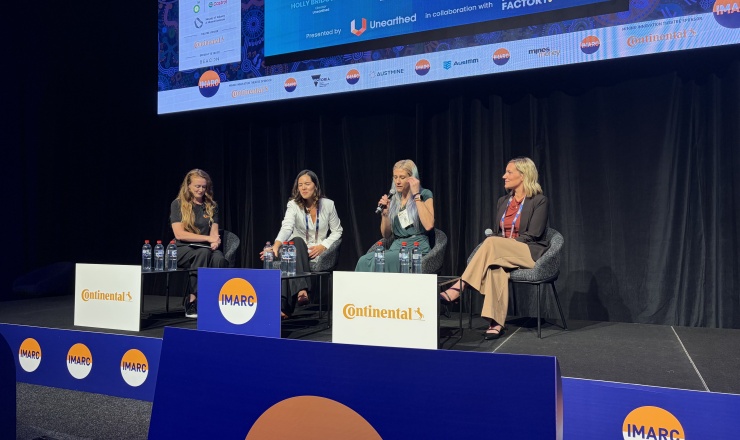
Funding the Future of Mining Tech at IMARC 2025
Hosted by Unearthed in collaboration with Founders Factory , our session “Funding the Future of Mining Tech” brought together a
Read articleUnearthed Brisbane 2015 saw an exciting weekend with over 75 developers, programmers, designers and engineers taking part in the first Unearthed event held in Queensland. 17 teams were formed to tackle five challenges focused on operational issues facing the resource industry. Final prototypes were pitched to a panel of judges, mentors and resource industry guests and judged based on creativity, viability, ease and potential impact.
Team ‘Smart Lumps’ (James Brown, Chris Fullelove, Micheil Cathcart and Samuel Huang) won first prize with their prototype tool for tracking and visualising live data from within a coal stockpile.
The prototype focused on mixing Wi-Fi enabled sensors into the pile, where they can monitor coal data until being extracted magnetically at the washplant. First prize included the chance to present as part of Australia’s largest mining conference, Austmine Tech Conference, as well as $1,500 cash and $3,000 in AWS credits.
We caught up with Chris Fullelove to find more about the process of development and their Unearthed Hackathon experience:
Q. Can you give us a quick description of the approach that you took and your prototype?
A. We were a team that were formed on the night. There were four of us – two with an electronics background and two with graphics and web development backgrounds. We were trying to address the stockpile visualisation problem.
The idea we came up with was to build cheap intelligent devices to disperse throughout stockpile. [They would] receive information in real time about the location and origin of the coal and track that through the lifecycle of the stockpile. This would provide coal mining operations a much better insight into the movements of stockpile itself as well as the different properties of materials in different places in the stockpile.
We built two of these prototypes over the weekend. Essentially, they were Wi-Fi enabled small pieces of electronics that were able to locate themselves in the room. If you extrapolated out that prototype, you would be able to use the same principle within a stockpile.
To show the sort of information that could be derived if you had several hundred [of these devices], we also built a 3D model to show how such data could be visualised.
Q. What are the backgrounds of the members of your group?
A. James is in electrical engineering and electronics and Micheil has a background in graphics design and web development. Samuel is in electrical engineering and worked for electronics comp in China before moving to Australia. I work in electrical engineering in traffic control systems.
Q. Could you describe your experience working in the resource space? Did you encounter any challenges?
A. Three of us didn’t have a specific background in resources. I’m in traffic control systems and [James and Samuel] are more in the field of pure electronics.
Micheil did have some experience through contracting to a company that worked in the resource space in resource quality management, so he was able to provide a little more context around the situation we were dealing with. The mentors available on the night had a lot of background in the resource sector so we could test out our ideas with them.
Q. What impact could your prototype hold for the industry? Do other industries use this current approach? [pullquote type="right"]Instead of making assumptions or trying to track manually which coal is put where in your stockpile, you can validate all with real data which can be tracked all the way back to the point of extraction[/pullquote]
A. We think that the prototype could have a couple of different impacts. It is an iterative technology. There are currently some passive technologies currently being used to track coal through the process.
Our device however allows you to get real time information about the stockpile and coal management throughout the lifecycle. Instead of making assumptions or trying to track manually which coal is put where in your stockpile, you can validate all with real data which can be tracked all the way back to the point of extraction. Consistent data is maintained throughout the life cycle.
I don’t know of anyone else using this sort of technology in other industries, although we did receive some interest on the night of using a similar approach in the agriculture space.
Q. What do you see as the potential future of your prototype?
A. It was targeted initially at coal stockpile management but we quickly realised many possible other uses – agriculture is the most applicable situation we could think to apply this to in the short term.
We also brainstormed ideas around package tracking or inventory tracking, where you would want to find the relative positions of inventory items. [pullquote type="left"]Keep an open mind – the crazy ideas can sometimes work[/pullquote]
Q. What tips can you give to future participants at Unearthed Hackathons?
A. Keep an open mind – the crazy ideas can sometimes work. Something that we were able to do quite well was to utilise mentors that were there. They know a lot and can help you turn an idea into a concept that has ground in reality.
Check out the second place winner's, team Haystack, submission for Oil Analysis Workflow & Prediction, and the Young Innovators Award winners, Pickle, for HedgeHog.
Have a look at some of the photos from the event Here.